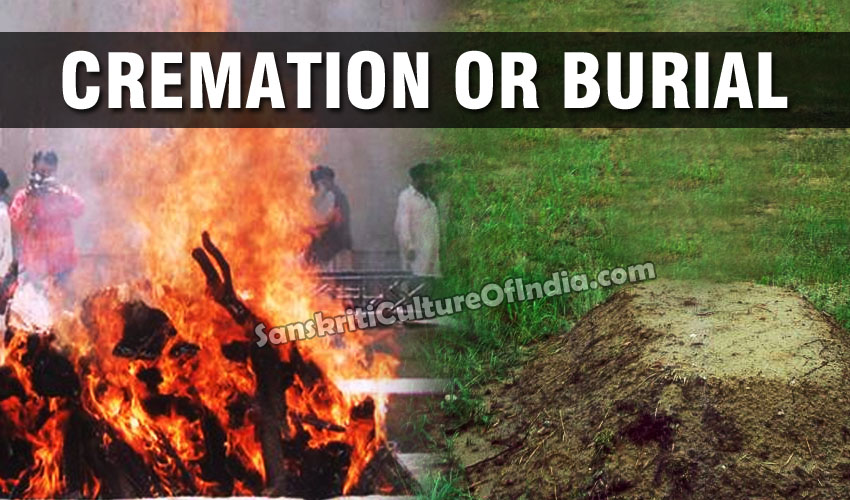‘What is the greatest wonder?’ Lord Yamraj asks in the Mahabharata.
Yudhisthir replies, ‘Day after day countless people die. Yet the living wish to live forever.’
Death has been an enigma from time immemorial. The human mind refuses to accept its utter finality. All civilizations and religions believe that somehow, the ‘individual’ keeps living, goes somewhere else, or will eventually ‘rise’ and reach heaven or hell. Hindus believe both in ‘life’ after death and in reincarnation.
On death, the subtle body goes to different planes of existence (including gradations of heaven and hell) and then, based on its record of good and bad deeds, it reincarnates on earth, in another body, to continue its journey towards perfection.
Hence, the manner and rituals regarding the disposal of the body after death assume great importance.
Burial vs. Cremation
In ancient Egypt, the physical body was preserved through an elaborate process of mummification, as it was believed that, without a home, the soul wandered around to be lost forever. Similarly, Chinese emperors were buried with replicas of objects called grave goods. Again the belief was that on death, the person enters an ‘after life.’ All the daily comforts of their past life such as servants, attendants, objects, pets, wives, guardians, concubines, food and drink were buried along with the emperor. In fact, at times the emperor’s favourite concubines were actually killed and buried with him!
Among the ancient Greeks and Romans, both cremation and burial were practiced. Christianity and Judaism discourage cremation and Islam prohibits it. Lately, more Christians are becoming open to the idea of cremation and opposition to it has now vanished among Protestants, but the Eastern Orthodox churches still forbid it. Many Liberal and Reform Jews support cremation as an option.
The Roman Catholic Church’s discouragement of cremation stems from the idea that the body is holy and should be treated with honour and respect. Moreover cremation constituted a denial of the resurrection of the body.
Burial as opposed to cremation, apparently, seems to be a ‘neater’ and ‘nicer’ way of disposal. However, since the whole dreadful process of gradual decomposition and decay of the body is not seen, cremation is, in actual fact, a ‘kinder’ method. Moreover, it is definitely preferable for environmental reasons. Since a traditional burial consumes nearly one tree, Hindus are enjoined to plant three trees, on special occasions, during their life span.
Hinduism and Cremation
Agni, consume not this body to cinders neither give it pain nor scatter about its skin or limbs. When the body is fairly burnt, convey the spirit to the ancestors. May the five elements be merged with their basic forms.
“Release him again, O Agni, to the fathers. The one offered to you now proceeds to his destiny. Putting on new life, let him approach the surviving, let him reunite with a [new] body, All-Knowing One!” (10. 16. 5).
~ Vedic hymn to Agni
Hinduism is unique among the world’s major religions in mandating cremation, called antim-sanskar (last rite) as one of the 16 life rituals. Jainism and Sikhism also strongly prefer cremation. Since Agni, the god of fire is seen as a link between the gross and subtle, matter and spirit, the seen and unseen, the known and unknown and a messenger between men and gods, dead bodies were disposed by cremation. Thus, the dead body is an offering to Agni with an earnest prayer to purify and lead the individual to a better and brighter life.
Hindus arrange swift cremation of the dead, ideally within 24 hours. The fire and accompanying rites sever ties to earthly life and give momentum to the soul for its continuing spiritual journey.
Another reason for preferring cremation is to produce a feeling of detachment in the freshly disembodied subtle body and to encourage it to pass on, rather than hover around loved ones. Moreover, Hindus, out of respect for the dead, did not want to leave the bodies around to be consumed by vultures and other animals.
In addition, burial sites utilize large areas of arable land. Earlier, digging a grave was laborious and required special implements compared to cremation which was easier, quicker and cheaper because everyone who came would bring along some wood for the fire.
The exceptions to cremation are saints, holy men and children. Since saints are supposed to have attained a high degree of detachment from the body, they do not need to be cremated – they are buried in the lotus position. For children too, the attachment to the body is much less. Also, according to custom, an offspring is required to light the funeral pyre, and both categories would normally not have any.
~ Kumkum Bhatia










